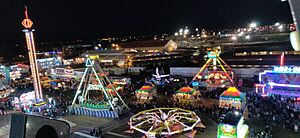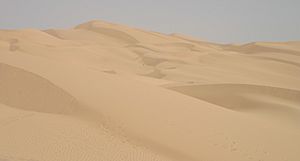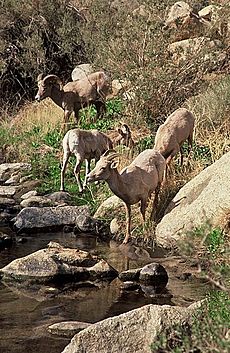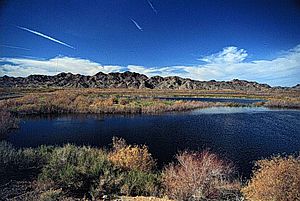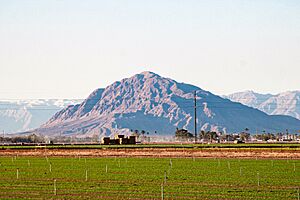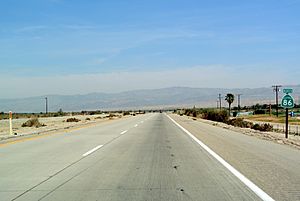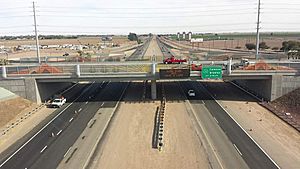Imperial County, California facts for kids
Quick facts for kids
Imperial County, California
|
|||
|---|---|---|---|
| County of Imperial | |||
|
Images, from top down, left to right: The fields of Imperial Valley, Salton Sea, Imperial County Courthouse
|
|||
|
|||
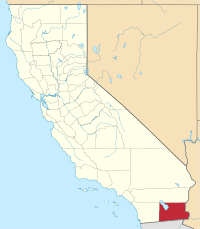
Location in the state of California
|
|||
| Country | United States | ||
| State | California
|
||
| Region | Imperial Valley | ||
| Incorporated | August 7, 1907 | ||
| Named for | Imperial Valley, which was named after the Imperial Land Company | ||
| County seat | El Centro | ||
| Largest community | El Centro (population) Salton City (area) |
||
| Government | |||
| • Type | Council–CEO | ||
| • Body | Board of Supervisors | ||
| Area | |||
| • Total | 4,482 sq mi (11,610 km2) | ||
| • Land | 4,177 sq mi (10,820 km2) | ||
| • Water | 305 sq mi (790 km2) | ||
| Highest elevation | 4,551 ft (1,387 m) | ||
| Lowest elevation | -232 ft (−70.7 m) | ||
| Population | |||
| • Total | 179,702 | ||
| • Density | 43/sq mi (17/km2) | ||
| GDP | |||
| • Total | $11.064 billion (2022) | ||
| Time zone | UTC−8 (Pacific Time Zone) | ||
| • Summer (DST) | UTC−7 (Pacific Daylight Time) | ||
| Area codes | 442/760 | ||
| FIPS code | 06-025 | ||
| GNIS feature ID | 277277 | ||
| Congressional district | 25th | ||
Imperial County (Spanish: Condado de Imperial) is a county located on the southeast border of the U.S. state of California. As of the 2020 census, the population was 179,702, making it the least populous county in Southern California. The county seat and largest city is El Centro. Imperial is the most recent California county to be established, as it was created in 1907 out of the eastern half of San Diego County.
Imperial County is located in the far southeast of California, in the Imperial Valley. It borders San Diego County to the west, Riverside County to the north, the U.S. state of Arizona to the east and the Mexican state of Baja California to the south. It includes the El Centro metropolitan statistical area and is part of the Southern California border region, the smallest but most economically diverse region in the state.
Although this region is a desert, with high temperatures and low average rainfall of 3 inches (76 mm) per year, the economy is strongly based on agriculture. This is supported by irrigation, with water supplied wholly from the Colorado River via the All-American Canal.
The Imperial Valley straddles the border between the United States and Mexico. Imperial County is strongly influenced by Mexican culture. Approximately 80% of the county's population is Hispanic, with the vast majority being of Mexican origin. The remainder of the population is predominantly non-Hispanic white, in addition to smaller African American, Native American, and Asian minorities.
Contents
History

The indigenous peoples of the area were the Quechan along the Colorado River, the Kamia-Kumeyaay west of the Quechan, and the Cahuilla to the north.
Spanish explorer Melchor Díaz was one of the first Europeans to visit the area of the Imperial Valley in 1540. The explorer Juan Bautista de Anza also explored the area in 1776. The indigenous peoples in the county were also engaged in an armed regional conflict, with the Quechan leading a coalition with the Kumeyaay against the Maricopa-led coalition with the Cahuilla, Cocopah, and other tribes in modern-day Arizona. Constant warfare would deny the Spanish explorers any overland access to Alta California, despite Spanish attempts to mediate the conflict.
Decades later, after the Mexican–American War, the northern half of the valley was annexed in 1848 by the U.S., while the southern half remained under Mexican rule.
Following the war, another war would consume the region in 1850 after the Glanton Gang sabotaged Quechan ferry operators and mugged a local Quechan chief. This would lead towards the start of the Yuma War, with a Quechan-led coalition of tribes against the US army and their indigenous allies in Baja California and Sonora. In the First Yuma War, the Quechan laid siege on Fort Yuma in 1851, and forced the American garrison there to abandon the fort. The Americans returned to the area in 1852 and subdued the Quechan by destroying their villages and farmland, and killed any warriors that resisted, leading to Quechan surrender to the US. The Second Yuma War would later see neighboring tribes erode much of the military advantages that the Quechan had left.
Small-scale settlement in natural aquifer areas had occurred in the early 19th century (the present-day site of Mexicali), but most permanent settlement was after 1900.
In 1905, torrential rainfall in the American Southwest caused the Colorado River (the only drainage for the region) to flood, including canals that had been built to irrigate the Imperial Valley. Since the valley is partially below sea level, the waters never fully receded, but collected in the Salton Sink in what is now called the Salton Sea.
Imperial County was formed in 1907 from the eastern portion of San Diego County. The county was named for Imperial Valley. This had been named for the Imperial Land Company, a subsidiary of the California Development Company, which at the turn of the 20th century had claimed the southern portion of the Colorado Desert for agriculture. The Imperial Land Company also owned extensive lands in Mexico (Baja California). Its objective was to develop commercial crop farming.
By 1910, the land company had managed to settle and develop thousands of farms on both sides of the border. The Mexican Revolution soon after severely disrupted the company's plans. Rival Mexican armies affiliated with different ethnicities killed nearly 10,000 farmers and their families in northern Mexico. Not until the 1920s was the other side of California in the United States sufficiently peaceful and prosperous for the company to earn a return for a large percentage of Mexicans. Some chose to stay and create roots in newly developed communities in the valley.
During the Great Depression and the Dust Bowl, the county attracted migrating "Okies" from drought-ridden farms on the plains by the need of migrant labor. More prosperous job-seekers also arrived from across the U.S. in the 1930s and 1940s. American entry into World War II stimulated the growth of jobs and need to expanded agriculture, and the All American Canal was completed from its source, the Colorado River, to Imperial Valley from 1948 to 1951. By the 1950 census, more than 50,000 residents lived in Imperial County alone, about 40 times the population of 1910. Most of the population was year-round, but would increase every winter by migrant laborers from Mexico. Until the 1960s, the farms in Imperial County provided substantial economic returns to the company and the valley.
During the Great Recession of 2008–11, El Centro had one of the highest unemployment rates (above 30–34%) in the U.S. In the early 2020s, Imperial ranks as one of California's poorest counties. It has a lower median household income than either the state or national medians.
Sites of interest
Fort Yuma
Fort Yuma is located on the banks of the Colorado River in Winterhaven, California. First established after the end of the Mexican–American War in 1848, it was originally located in the bottoms near the Colorado River, less than 1 mile (1.6 km) below the mouth of the Gila River. It was to defend the newly settled community of Yuma, Arizona, on the other side of the Colorado River and the nearby Mexican border. In March 1851 the post was moved to a small elevation on the Colorado's west bank, opposite the present city of Yuma, Arizona, on the site of the former Mission Puerto de Purísima Concepción. This site had been occupied by Camp Calhoun, named for John C. Calhoun, established in 1849. Fort Yuma was established to protect the southern emigrant travel route to California and to attempt control of the Yuma Indians in the surrounding 100-mile (160 km) area.
Blue Angels
NAF El Centro is the winter home of the U.S. Navy Flight Demonstration Squadron, The Blue Angels. NAF El Centro historically kicks off the Blue Angels' season with their first air show, traditionally held in March.
Imperial Valley Expo & Fairgrounds
The city of Imperial is home to the California Mid-Winter Fair and Fiesta which is the local county fair, held in late February to early March. It is also home to the Imperial Valley Speedway, a race track of 3⁄8 mile (600 m).
Algodones Sand Dunes
The name Algodones Dunes refers to the entire geographic feature, while the administrative designation for that portion managed by the Bureau of Land Management is the "Imperial Sand Dunes Recreation Area" (sometimes called the "Glamis Dunes"). The Algodones Sand Dunes are the largest mass of sand dunes in California. This dune system extends for more than 40 miles (64 km) along the eastern edge of the Imperial Valley agricultural region in a band averaging 5 miles (8 km) in width. A major east–west route of the Union Pacific railroad skirts the eastern edge. The dune system is divided into three areas. The northernmost area is known as Mammoth Wash. South of Mammoth Wash is the North Algodones Dunes Wilderness established by the 1994 California Desert Protection Act. This area is closed to motorized use and access is by hiking and horseback. The largest and most heavily used area begins at Highway 78 and continues south just past Interstate 8. The expansive dune formations offer picturesque scenery, a chance to view rare plants and animals, and a playground for ATV and off-roading enthusiasts. The dunes are also popular in film making and have been the site for movies such as Return of the Jedi.
Colorado River
The Colorado River streams through the southwestern United States and northwestern Mexico, approximately 1,450 miles (2,330 km) long, draining a part of the arid regions on the western slope of the Rocky Mountains. The natural course of the river flows from north of Grand Lake, Colorado, into the Gulf of California. For many months out of the year, however, no water actually flows from the United States to the gulf, due to human use. The river is a popular destination for water sports, including fishing, boating, water skiing, and jet skiing.
Salvation Mountain
Salvation Mountain is an artificial mountain north of Calipatria, California, near Slab City. It is made from adobe, straw, and thousands of gallons of paint. It was created by Leonard Knight to convey the message that "God Loves Everyone". Knight refused substantial donations of money and labor from supporters who wished to modify his message of universal love to favor or disfavor particular groups.
Anza-Borrego Desert State Park
Anza-Borrego Desert State Park, portions of which are located in Imperial County, is the largest state park in California. 500 miles (800 km) of dirt roads, twelve wilderness areas, and many more miles of hiking trails provide visitors with an unparalleled opportunity to experience the wonders of the Colorado Desert. The park's name is a combination of the last name of Spanish explorer Juan Bautista de Anza, and the Spanish word for bighorn sheep, borrego. The park features many sweeping vistas, washes (wadis), rocky outcrops, boulder-strewn hillsides, in addition to the vast expanses of sandy desert; in springtime (especially after periods of rain), these areas appear to change shape, as they come alive with blooming wildflowers, flowering and fruiting cacti and numerous other species of native flora. Fauna that visitors may also have the chance to see include the bobcat, coyote, golden eagle, kit fox, mule deer, mountain lion, red-tailed hawk and roadrunner, as well as the iconic desert subspecies of bighorn sheep (formerly more common, across the southwest U.S. and northern Mexico). Many varied reptile species call the area home, such as the banded gecko, chuckwalla, desert iguana, desert tortoise, desert sidewinder, gopher snake, kingsnake, red diamond rattlesnake and the rosy boa.
Fossil Canyon and Painted Gorge
Located near Ocotillo, California in the Coyote Mountains, Fossil Canyon (and the surrounding area) is a great place for rock-hounding and fossil hunting. The fossils here are not necessarily of dinosaurs; more commonly found are ancient oyster and seashell, coral, and other marine life from the prehistoric Miocene epoch, when the entire area was submerged as part of the Western Interior Seaway.
The Painted Gorge, located on the eastern side of the Coyote Mountains, consists of sedimentary, metamorphic and igneous rock; Heat and movement over time has created fantastic shapes and colors. Dark ochre, iron-reds, royal purples, and mauves (mixed with dark browns/black) create a palette of color as the sun illuminates and plays shadows upon this geologic wonder.
Imperial NWR
The Imperial National Wildlife Refuge protects wildlife habitat along 30 miles (50 km) of the lower Colorado River in Arizona and California, including the last un-channeled section before the river enters Mexico. The river and its associated backwater lakes and wetlands are a green oasis, contrasting with the surrounding desert mountains. It is a refuge and breeding area for migratory birds and local desert wildlife.
Sonny Bono Salton Sea NWR
The Sonny Bono Salton Sea National Wildlife Refuge is located 40 miles (64 km) north of the Mexican border at the southern end of the Salton Sea in California's Imperial Valley. Situated along the Pacific Flyway, the refuge is the only one of its kind, located 227 feet (69 m) below sea level. Because of its southern latitude, elevation, and location in the Colorado Desert, the refuge experiences some of the highest temperatures in the nation. Daily temperatures from May to October generally exceed 100 °F (38 °C) with temperatures of 116–120 °F (47–49 °C) recorded yearly.
Museum of History in Granite
The Museum of History in Granite in the town of Felicity exhibits granite monuments made from Missouri Red Granite. Each is 100 feet (30 m) long. Subjects include a Korean War Memorial, History of Arizona, The Wall for the Ages, the eight monument History of Humanity, and the History of the United States of America. Smaller monuments include the Felicity Stone (sm), a Rosetta Stone for the future located at the center of the History of Humanity monuments.
Geography
According to the U.S. Census Bureau, the county has a total area of 4,482 square miles (11,610 km2), of which 4,177 square miles (10,820 km2) is land and 305 square miles (790 km2) (6.8%) is water. Much of Imperial County is below sea level. Imperial County is roughly twice the size in total square miles as the State of Delaware.
Imperial county is bordered on the north by Riverside County; on the east by Yuma County, Arizona; on the south by Mexico; and on the west by San Diego County. The Colorado River forms the county's eastern boundary. Two notable geographic features are found in the county, the Salton Sea, at 235 feet (72 m) below sea level, and the Algodones Dunes, one of the largest dune fields in America.
The county is in the Colorado Desert, an extension of the larger Sonoran Desert. The Chocolate Mountains are located east of the Salton Sea, and extend in a northwest–southeast direction for approximately 60 miles (97 km).
In this region, the geology is dominated by the transition of the tectonic plate boundary from rift to fault. The southernmost strands of the San Andreas Fault connect the northernmost extensions of the East Pacific Rise. Consequently, the region is subject to earthquakes, and the crust is being stretched, resulting in a sinking of the terrain over time. Related to the active geology are some interesting hydrothermal features. The area is also volcanic with multiple volcanic eruptions in the past few thousand years the most recent was 1,800 years ago.
National protected areas
- Cibola National Wildlife Refuge (part)
- Imperial National Wildlife Refuge (part)
- Sonny Bono Salton Sea National Wildlife Refuge
Demographics
2011
| Population, race, and income | |||||
|---|---|---|---|---|---|
| Total population | 171,343 | ||||
| White | 115,496 | 67.4% | |||
| Black or African American | 5,985 | 3.5% | |||
| American Indian or Alaska Native | 3,020 | 1.8% | |||
| Asian | 2,757 | 1.6% | |||
| Native Hawaiian or other Pacific Islander | 83 | 0.0% | |||
| Some other race | 38,604 | 22.5% | |||
| Two or more races | 5,398 | 3.2% | |||
| Hispanic or Latino (of any race) | 136,376 | 79.6% | |||
| Per capita income | $16,593 | ||||
| Median household income | $39,402 | ||||
| Median family income | $43,769 | ||||
Places by population, race, and income
| Places by population and race | ||||||||
|---|---|---|---|---|---|---|---|---|
| Place | Type | Population | White | Other |
Asian | Black or African American |
Native American |
Hispanic or Latino (of any race) |
| Bombay Beach | CDP | 459 | 69.7% | 0.0% | 0.0% | 30.3% | 0.0% | 0.0% |
| Brawley | City | 26,645 | 78.0% | 16.2% | 0.9% | 4.2% | 0.7% | 80.1% |
| Calexico | City | 40,378 | 64.4% | 34.1% | 1.0% | 0.2% | 0.3% | 96.4% |
| Calipatria | City | 7,292 | 66.8% | 21.1% | 1.5% | 9.0% | 1.7% | 75.5% |
| Desert Shores | CDP | 1,104 | 94.4% | 5.6% | 0.0% | 0.0% | 0.0% | 86.3% |
| El Centro | City | 44,206 | 65.1% | 28.6% | 2.6% | 3.1% | 0.7% | 79.6% |
| Heber | CDP | 6,008 | 57.7% | 39.0% | 0.0% | 0.0% | 3.2% | 98.6% |
| Holtville | City | 6,088 | 68.0% | 29.0% | 1.0% | 0.4% | 1.6% | 80.5% |
| Imperial | City | 18,206 | 76.4% | 17.5% | 2.3% | 2.4% | 1.4% | 76.1% |
| Niland | CDP | 1,112 | 86.7% | 8.7% | 0.0% | 1.2% | 3.4% | 61.7% |
| Ocotillo | CDP | 253 | 98.8% | 0.0% | 0.0% | 0.0% | 1.2% | 7.1% |
| Palo Verde | CDP | 171 | 73.0% | 22.8% | 1.0% | 3.0% | 1.0% | 19.0% |
| Salton City | CDP | 3,768 | 77.2% | 20.0% | 0.0% | 2.8% | 0.0% | 47.9% |
| Salton Sea Beach | CDP | 598 | 63.0% | 10.2% | 1.8% | 0.0% | 24.9% | 53.8% |
| Seeley | CDP | 1,683 | 79.8% | 17.8% | 0.0% | 2.4% | 0.0% | 79.1% |
| Westmorland | City | 2,714 | 90.7% | 6.2% | 0.0% | 1.1% | 2.0% | 87.9% |
| Winterhaven | CDP | 493 | 50.9% | 5.9% | 10.8% | 0.0% | 32.5% | 81.5% |
| Places by population and income | |||||
|---|---|---|---|---|---|
| Place | Type | Population | Per capita income | Median household income | Median family income |
| Bombay Beach | CDP | 459 | $12,439 | $19,375 | $24,063 |
| Brawley | City | 26,645 | $17,709 | $36,233 | $43,328 |
| Calexico | City | 40,378 | $14,317 | $35,988 | $39,129 |
| Calipatria | City | 7,292 | $11,559 | $35,030 | $37,381 |
| Desert Shores | CDP | 1,104 | $11,610 | $29,345 | $29,732 |
| El Centro | City | 44,206 | $18,273 | $38,297 | $42,417 |
| Heber | CDP | 6,008 | $13,540 | $45,044 | $44,444 |
| Holtville | City | 6,088 | $20,749 | $40,712 | $42,188 |
| Imperial | City | 18,017 | $21,378 | $57,152 | $57,548 |
| Niland | CDP | 1,112 | $9,750 | $14,883 | $15,170 |
| Ocotillo | CDP | 253 | $15,254 | $17,734 | $20,625 |
| Palo Verde | CDP | 171 | $44,003 | $59,676 | |
| Salton City | CDP | 3,768 | $16,887 | $32,925 | $34,792 |
| Salton Sea Beach | CDP | 598 | $17,791 | $27,375 | $57,159 |
| Seeley | CDP | 1,683 | $14,126 | $33,977 | $44,063 |
| Westmorland | City | 2,714 | $13,179 | $28,375 | $30,804 |
| Winterhaven | CDP | 493 | $9,207 | $35,074 | $35,441 |
2010
| Historical population | |||
|---|---|---|---|
| Census | Pop. | %± | |
| 1910 | 12,591 | — | |
| 1920 | 43,453 | 245.1% | |
| 1930 | 60,903 | 40.2% | |
| 1940 | 55,740 | −8.5% | |
| 1950 | 61,175 | 9.8% | |
| 1960 | 71,105 | 16.2% | |
| 1970 | 74,492 | 4.8% | |
| 1980 | 93,110 | 25.0% | |
| 1990 | 109,303 | 17.4% | |
| 2000 | 142,361 | 30.2% | |
| 2010 | 174,528 | 22.6% | |
| 2020 | 179,702 | 3.0% | |
| 2023 (est.) | 179,057 | 2.6% | |
| U.S. Decennial Census 1790–1960 1900–1990 1990–2000 2010–2015 |
|||
The 2010 United States Census reported that Imperial County had a population of 174,528. The racial makeup of Imperial County was 102,553 (58.8%) White, 5,773 (3.3%) African American, 3,059 (1.8%) Native American, 2,843 (1.6%) Asian, 165 (0.1%) Pacific Islander, 52,413 (30.0%) from other races, and 7,722 (4.4%) from two or more races. Hispanic or Latino of any race were 140,271 persons (80.4%).
| Population reported at 2010 United States Census | |||||||||
|---|---|---|---|---|---|---|---|---|---|
|
|
Population |
|
American |
American |
|
Islander |
races |
more races |
or Latino (of any race) |
| Imperial County | 174,528 | 102,553 | 5,773 | 3,059 | 2,843 | 165 | 52,413 | 7,722 | 140,271 |
|
city |
Population |
|
American |
American |
|
Islander |
races |
more races |
or Latino (of any race) |
| Brawley | 24,953 | 13,570 | 510 | 241 | 349 | 32 | 9,258 | 993 | 20,344 |
| Calexico | 38,572 | 23,150 | 134 | 204 | 504 | 21 | 12,920 | 1,639 | 37,354 |
| Calipatria | 7,705 | 3,212 | 1,612 | 79 | 95 | 25 | 2,455 | 227 | 4,940 |
| El Centro | 42,598 | 25,376 | 1,081 | 554 | 965 | 34 | 12,356 | 2,232 | 34,751 |
| Holtville | 5,939 | 3,655 | 37 | 41 | 50 | 4 | 1,977 | 175 | 4,858 |
| Imperial | 14,758 | 9,298 | 331 | 154 | 370 | 13 | 3,783 | 809 | 11,046 |
| Westmorland | 2,225 | 1,038 | 21 | 38 | 11 | 0 | 1,042 | 75 | 1,938 |
|
place |
Population |
|
American |
American |
|
Islander |
races |
more races |
or Latino (of any race) |
| Bombay Beach | 295 | 223 | 37 | 8 | 1 | 0 | 22 | 4 | 59 |
| Desert Shores | 1,104 | 709 | 8 | 26 | 4 | 1 | 307 | 49 | 848 |
| Heber | 4,275 | 2,174 | 5 | 33 | 15 | 0 | 1,758 | 290 | 4,197 |
| Niland | 1,006 | 539 | 36 | 20 | 36 | 0 | 315 | 60 | 618 |
| Ocotillo | 266 | 242 | 1 | 1 | 2 | 0 | 17 | 3 | 61 |
| Palo Verde | 171 | 124 | 2 | 5 | 1 | 0 | 26 | 13 | 33 |
| Salton City | 3,763 | 2,260 | 80 | 61 | 61 | 5 | 1,159 | 137 | 2,368 |
| Salton Sea Beach | 422 | 309 | 6 | 4 | 2 | 2 | 82 | 17 | 229 |
| Seeley | 1,739 | 746 | 19 | 7 | 21 | 2 | 793 | 151 | 1,489 |
| Winterhaven | 394 | 245 | 4 | 37 | 1 | 0 | 84 | 23 | 261 |
|
unincorporated areas |
Population |
|
American |
American |
|
Islander |
races |
more races |
or Latino (of any race) |
| All others not CDPs (combined) | 24,343 | 15,683 | 1,849 | 1,546 | 355 | 26 | 4,059 | 825 | 14,877 |
2000
As of the census of 2000, there were 142,361 people, 39,384 households, and 31,467 families residing in the county. The population density was 34 people per square mile (13 people/km2). There were 43,891 housing units at an average density of 10 per square mile (3.9/km2). The racial makeup of the county was 49.4% White, 4.0% Black or African American, 1.9% Native American, 2.0% Asian, 0.1% Pacific Islander, 39.1% from other races, and 3.7% from two or more races. 72.2% of the population were Hispanic or Latino of any race. 65.7% spoke Spanish at home, while 32.3% spoke only English.
There were 39,384 households, out of which 46.7% had children under the age of 18 living with them, 57.7% were married couples living together, 17.1% had a female householder with no husband present, and 20.1% were non-families. 17.1% of all households were made up of individuals, and 8.1% had someone living alone who was 65 years of age or older. The average household size was 3.33 and the average family size was 3.77.
In the county, the population was spread out, with 31.4% under the age of 18, 9.9% from 18 to 24, 30.4% from 25 to 44, 18.2% from 45 to 64, and 10.0% who were 65 years of age or older. The median age was 31 years. For every 100 females there were 109.3 males. For every 100 females age 18 and over, there were 111.4 males.
The median income for a household in the county was $31,870, and the median income for a family was $35,226. Males had a median income of $32,775 versus $23,974 for females. The per capita income for the county was $13,239. About 19.4% of families and 22.6% of the population were below the poverty line, including 28.7% of those under age 18 and 13.6% of those age 65 or over.
Imperial County has the lowest per capita income of any county in Southern California and among the bottom five counties in the state.
By 2006 the population had risen to 160,201, the population growth rate since the year 2000 was 30%, the highest in California and fifth highest in the United States in the time period. High levels of immigration, new residents search for affordable homes, and a search for retirement homes can explain the population increase.
Economy
Thousands of acres of prime farmland have transformed the desert into one of the most productive farming regions in California with an annual crop production of over $1 billion. Agriculture is the largest industry in Imperial County and accounts for 48% of all employment. Although this region is a desert, with high temperatures and low average rainfall of 3 inches (76 mm) per year, the economy is heavily based on agriculture due to irrigation, which is supplied wholly from the Colorado River via the All-American Canal.
A vast system of canals, check dams, and pipelines carry the water all over the valley, a system which forms the Imperial Irrigation District, or IID. The water distribution system includes over 1,400 miles (2,300 km) of canal and with 1,100 miles (1,800 km) of pipeline. The number of canal and pipeline branches number roughly over a hundred. Imported water and a long growing season allow two crop cycles each year, and the Imperial Valley is a major source of winter fruits and vegetables, cotton, and grain for U.S. and international markets. Alfalfa is another major crop produced in the Imperial Valley. The agricultural lands are served by a constructed agricultural drain system, which conveys surface runoff and subsurface drainage from fields to the Salton Sea, which is a designated repository for agricultural runoff. Imperial County produces nearly 2/3 of all vegetables consumed by Americans during the winter.
El Centro is the commercial center of Imperial County. Fifty percent of the jobs in El Centro come from the service and retail sector.
A recent growth in the interest of Imperial County as a filming location, has spurred growth in servicing this industry. Because of the county's desert environment and proximity to Los Angeles, California, movies are sometimes filmed in the sand dunes outside the agricultural portions of the county. These have included Return of the Jedi, Stargate, The Scorpion King, and Into the Wild. Additionally, portions of the 2005 film Jarhead were filmed here because of its similarity to the desert terrain of Iraq.
In 2016, Imperial County had the highest unemployment rate of any county in the United States, at 23.5%.
Cotton in Imperial County and Riverside is predominantly Bt cotton. This is in contrast to the rest of the state, which largely relies on non-incorporated pesticides. The introduction of Bt cotton has dramatically reduced pesticide use here.
Renewable energy
Imperial Valley has become a hotbed of renewable energy projects, both solar and geothermal. This is driven in part by California's mandate to generate 20% of its power from renewable sources by the end of 2010, the valley's excellent sun resources, the high unemployment, its proximity to large population centers on the coast, and large tracts of otherwise unusable desert land. Much of the land suitable for green energy is owned by the federal government (Bureau of Land Management). As of April 2008, the BLM has received 163 applications to build renewable energy projects on 1,600,000 acres (6,500 km2) in California. Almost all of these are planned for the Imperial Valley and the desert region north of the valley. Stirling Energy is currently building one of the world's largest solar thermal plants, 10 square miles (26 km2) with 38,000 "sun catchers," it will power up to 600,000 homes once it is fully operational by around 2015. CalEnergy runs a geothermal plant that generates enough power for 300,000 homes and could tap into more for up to 2.5 million homes.
Transportation
Major highways
 Interstate 8
Interstate 8 State Route 7
State Route 7 State Route 78
State Route 78 State Route 86
State Route 86 State Route 98
State Route 98 State Route 111
State Route 111 State Route 115
State Route 115 State Route 186
State Route 186
Imperial County is at the junction of one interstate, and three state highways. Radiating to the east and west are connections to the Arizona Sun Corridor and San Diego-Tijuana metropolitan area via Interstate 8, Blythe, and northern San Diego County via State Route 78, the Mexicali Valley via State Route 111, and the Coachella Valley, Inland Empire, and Los Angeles metropolitan area via State Route 86.
Public transportation
Imperial County is served by Greyhound Lines and Imperial Valley Transit buses. Through a partnership between Imperial County Transportation Commission (ICTC), the Yuma County Intergovernmental Public Transportation Authority (YCIPTA), and the Quechan Indian Tribe, Yuma County Area Transit buses serve portions of Imperial County and connects it to Yuma, Arizona. Amtrak trains on the Sunset Limited and Texas Eagle route also travel through the county, but with no scheduled stops; the nearest stop is in Yuma, Arizona.
Airports
County owned
- Imperial County Airport, the county's main airport, is primarily a general aviation facility. It is located just north of El Centro, and has limited commercial flight service subsidized by the Essential Air Service program.
- Holtville Airport is a public use general aviation airport, owned by the county and located roughly 5 miles (8 km) east of Holtville.
Municipal ownership
- Brawley Municipal Airport is a public use general aviation airport, owned by and located in Brawley.
- Calexico Airport is a public use general aviation field, owned by and located in Calexico. It is located 15 miles (24 km) south of Interstate 8 on State Route 111. It used in part to service maquiladora factories in nearby Mexicali.
- Cliff Hatfield Memorial Airport is a public use general aviation airport, owned by and located in Calipatria.
Privately owned
- Salton Sea Airport is a public use general aviation airport located in Salton City.
- Douthitt Strip Airport is a private use facility in El Centro. It was formerly a military airfield.
Military
- Naval Air Facility El Centro is a U.S. Navy airfield in El Centro.
Communities
Cities
- Brawley
- Calexico
- Calipatria
- El Centro (county seat)
- Holtville
- Imperial
- Westmorland
Census-designated places
Unincorporated communities
- Alamorio
- Andrade
- Bard
- Bonds Corner
- Boulder Park
- Coyote Wells
- Dixieland
- Felicity
- Glamis
- Kane Spring
- Meloland
- Mount Signal
- Obregon
- Picacho
- Plaster City
- Rockwood
- Slab City
Former settlements
Indian Reservations
- Fort Yuma Indian Reservation (partially in Yuma County, Arizona)
- Torres-Martinez Indian Reservation (partially in Riverside County)
Population ranking
The population ranking of the following table is based on the 2010 census of Imperial County.
† county seat
| Rank | City/Town/etc. | Municipal type | Population (2010 Census) |
|---|---|---|---|
| 1 | † El Centro | City | 42,598 |
| 2 | Calexico | City | 38,572 |
| 3 | Brawley | City | 24,953 |
| 4 | Imperial | City | 14,758 |
| 5 | Calipatria | City | 7,705 |
| 6 | Holtville | City | 5,939 |
| 7 | Torres-Martinez Reservation | AIAN | 5,594 |
| 8 | Heber | CDP | 4,275 |
| 9 | Salton City | CDP | 3,763 |
| 10 | Westmorland | City | 2,225 |
| 11 | Fort Yuma Indian Reservation (partially in Yuma County, AZ) | AIAN | 2,189 |
| 12 | Seeley | CDP | 1,739 |
| 13 | Desert Shores | CDP | 1,104 |
| 14 | Niland | CDP | 1,006 |
| 15 | Salton Sea Beach | CDP | 422 |
| 16 | Winterhaven | CDP | 394 |
| 17 | Bombay Beach | CDP | 295 |
| 18 | Ocotillo | CDP | 266 |
| 19 | Palo Verde | CDP | 171 |
Area codes
442/760 – Covers all of the El Centro metropolitan area as well as Palm Springs, Oceanside, Bishop, Ridgecrest, Barstow, and Needles; northern San Diego County; and southeastern California, including much of the Mojave Desert and the Owens Valley. Area code 760 split from area code 619 on March 22, 1997, and was overlaid with area code 442 in 2009.
Education
School districts are:
Unified:
- Calexico Unified School District
- Calipatria Unified School District
- Coachella Valley Unified School District
- Holtville Unified School District
- Imperial Unified School District
- San Pasqual Valley Unified School District
Secondary:
- Brawley Union High School District
- Central Union High School District
Elementary:
- Brawley Elementary School District
- El Centro Elementary School District
- Heber Elementary School District
- Magnolia Union Elementary School District
- McCabe Union Elementary School District
- Meadows Union Elementary School District
- Mulberry Elementary School District
- Seeley Union Elementary School District
- Westmorland Union Elementary School District
See also
 In Spanish: Condado de Imperial para niños
In Spanish: Condado de Imperial para niños








